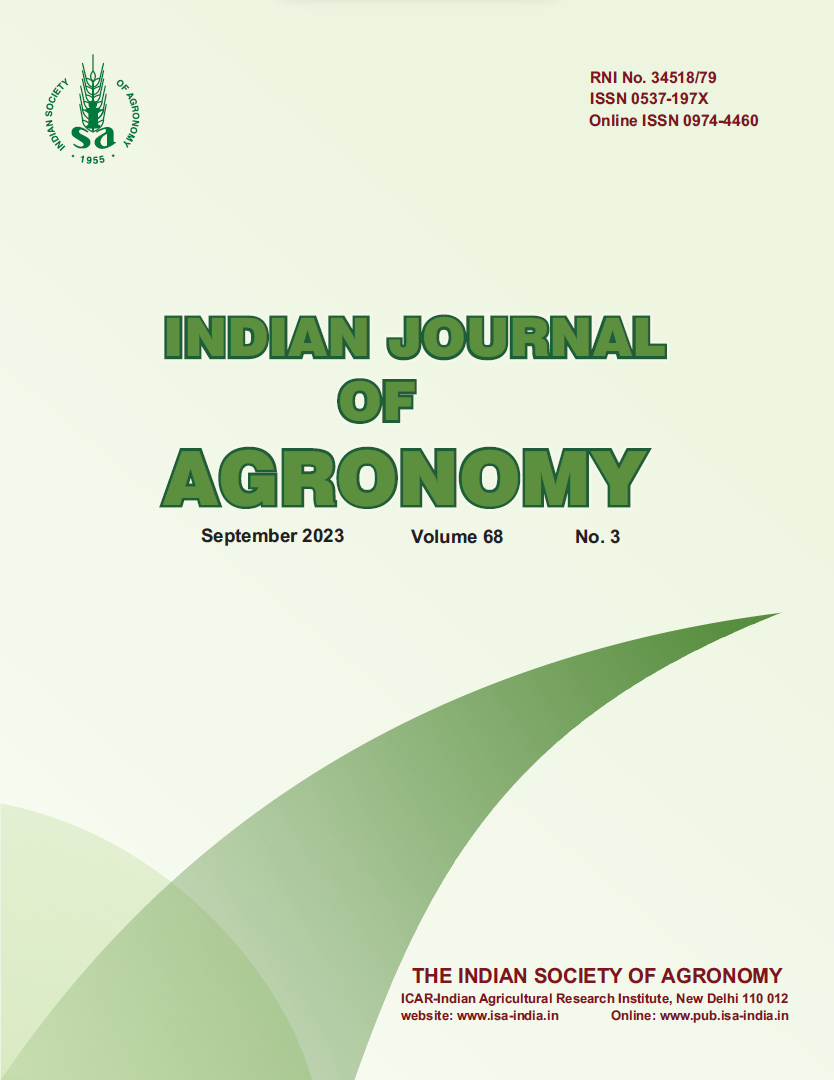Effect of crop-establishment methods on growth, yield, and economics of lathyrus (Lathyrus sativus) varieties in Vindhya Alluvial region of West Bengal
DOI:
https://doi.org/10.59797/ija.v68i3.2820Keywords:
Economics, Establishment method, Growth, Lathyrus, Variety, YieldAbstract
A field experiment was conducted at Bidhan Chandra Krishi Viswavidyalaya, Nadia, West Bengal, during the winter (rabi) season of 2020–21, to study the performance of 3 lathyrus varieties (‘Nirmal’, ‘Prateek’ and ‘Ratan’) under 3 establishment methods (broadcasting, line sowing and dibbling). Broadcast-sown lathyrus emerged early (4.9 days) with the highest emergence rate (96.5%) and recorded the maximum plant population (30.2/m2 ) compared to line sowing and dibbling method. Lathyrus variety ‘Ratan’ recorded the highest aerial dry-matter (94.5 g/ m2 ) at 80 days after sowing (DAS) and crop-growth rate (CGR) 1.74 g/m2 /day at 60–80 DAS, but ‘Nirmal’ produced the tallest plants (110.9 cm) and maximum branches/plant (8.5) at harvesting. Lathyrus raised in line-sown plots yielded the highest (1,757 kg/ha), being 6.7 and 27.3% greater than dibbling and broadcasting methods, respectively. Among the 3 varieties, ‘Ratan’ gave the highest grain yield (1,672 kg/ha) mainly owing to greater number of pods/plant (59.4), maximum net income (`34,989/ha) and benefit: cost ratio (2.06) compared to ‘Prateek’ (1,605 kg/ha) and ‘Nirmal’ (1,507 kg/ha).
References
Gupta, S. and Bhowmick, M.K. 2005. Scope of growing lathyrus and lentil in relay cropping systems after rice, West Bengal, India. Lathyrus Lathyrism Newsletter 4: 28–33. https://agricoop.nic.in.
Kar, G. and Kumar, A. 2009. Evaluation of post-rainy season crops with residual soil moisture and different tillage methods in rice fallow of eastern India. Agricultural Water Management 96(6): 931–938.
Mondal, S.S., Ghosh, A., Acharya, D. and Maiti, D. 2004. Productivity of grasspea (Lathyrus sativus L.) under different levels of phosphorus and foliar spray of molbdenum. Indian Journal of Agronomy 49(1): 6–9.
Rahmianna, A.A., Adisarwanto, T., Kirchho, G. and So, H.B. 2000. Crop establishment of legumes in rainfed lowland rice-based cropping systems. Soil Tillage Research 56(1–2): 67–82.
Sorokhaibam, S., Singh N.A. and Nabachandra, L. 2016. Effect of liming, planting time and tillage on system productivity, resource use efficiency and energy dynamics of rice (Oryza sativa)–lathyrus (Lathyrus sativus) cropping system under rainfed lowland condition of North East India. International Journal of Legume Research 40(3): 506–513.






